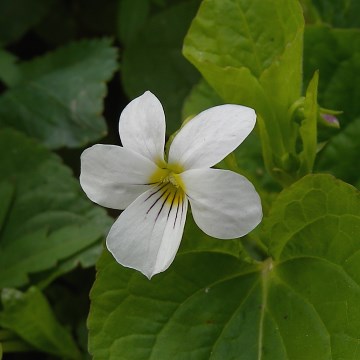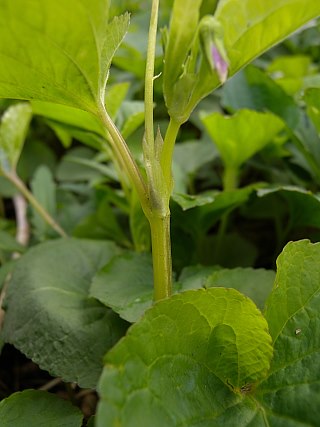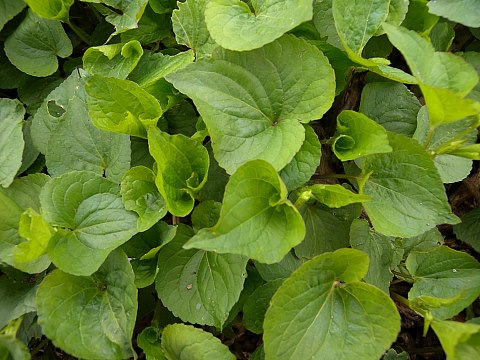Description: This perennial wildflower is 6-14" tall, producing both basal and cauline leaves. The blades of both basal and cauline leaves are up to 4" long and 2½" across; they are medium to dark green, cordate or oval-cordate, palmately veined, and slightly crenate along their margins. The upper surfaces of the blades are hairless. For the typical variety of Canada Violet, the lower surfaces of the blades are largely hairless, except for fine hairs along the major veins. For var. rugulosa, these lower surfaces are more hairy. Basal leaves have longer petioles than cauline leaves. The flowering plants produce stems with alternate leaves. These stems are light green, somewhat angular, and sometimes finely pubescent. At the base of the petioles of each alternate leaf, there is a pair of linear-lanceolate stipules up to 1/3" (8 mm.) long; these stipules lack teeth.

Individual flowers
are produced from the axils of the alternate leaves. The slender
pedicels raise the flowers only a little above the foliage. Each flower
is ½–¾" across, consisting of 5 white petals, 5 light green sepals, and
a short nectar spur; the petals are much larger than the sepals. The
reproductive organs are largely hidden within the throat of the flower.
The lower petal has dark purple veins, while the two lateral petals
have such veins to a lesser extent. The two lateral petals also have
small tufts of hairs near the throat of the flower, where there is a
conspicuous yellow patch. The back sides of the petals are light
purple. The blooming period occurs from mid-spring to early summer and
sometimes during the fall. Usually, only a few flowers are in bloom at
the same time. Later in the summer, inconspicuous cleistogamous flowers
are produced, which are self-fertile. Each fertile flower is replaced
by an ovoid seed capsule up to ½" long. This capsule is initially
green, but it later turns brown and divides into 3 segments, flinging
the seeds. The root system is fibrous and either rhizomatous or
stoloniferous. Colonies of plants are often produced.

Cultivation:
This violet prefers dappled sunlight to light shade during the spring,
but tolerates greater shade during the summer. Other cultural
requirements include more or less mesic conditions, a rich soil
containing loam and decaying organic matter, and cool summer
temperatures.
Range & Habitat:
Canada Violet is a rare wildflower that is restricted to the
northern two tiers of counties in Illinois (see Distribution
Map). It is state-listed as "endangered." It is native to the
driftless area of NW Illinois, while populations in NE Illinois may be
descendants of plants that have escaped cultivation. Habitats include
mesic deciduous woodlands and bluffs. Canada Violet is normally found
in high quality woodlands, although escaped cultivated plants are
likely to appear in more disturbed areas.
Faunal Associations:
The nectar and pollen of the flowers attract primarily bees, including
bumblebees, Little Carpenter bees (Ceratina spp.), digger bees
(Synhalonia spp.), Mason bees (Osmia spp.), and Andrenid bees. The
Andrenid bee, Andrena violae, is an oligolectic
visitor of violet flowers. Other floral visitors include bee flies and
occasional skippers and butterflies. These latter insects seek nectar.
The larvae of many moths and butterflies feed on the foliage of violets
(see Lepidoptera
Table). These larvae often hide during the day, but come out
at night to feed. Other insects that feed on violets include Neotoxoptera
violae (Violet Aphid), the larvae of Ametastegia
pallipes (Violet Sawfly), and Odontothrips
pictipennis (Thrips sp.). Among vertebrate animals, the
Ruffed Grouse and Wild Turkey eat the seeds and fleshy roots. Other
animals that occasionally feed on violets in wooded areas include the
White-Tailed Deer (foliage), Eastern Chipmunk (stems & leaves),
White-Footed Mouse (seeds), and Wood Turtle (Clemmys insculpta).
However, the importance of violets as a food source to vertebrate
animals is relatively low.
Photographic Location:
Bob Vaiden's wildflower garden in Urbana, Illinois.

Comments: Canada Violet is somewhat similar in appearance to Viola striata (Cream Violet). It differs from the latter by the yellow patch at the throat of its flowers, petals with pale purple backsides, and toothless stipules. Other white-flowered violets in the Midwest are stemless; they produce both flowers and leaves from the crown of the root system. The leaves of Canada Violet have tips that are more slender and elongated than those of most other violets, regardless of the color of their flowers. Both the flowers and foliage are attractive.